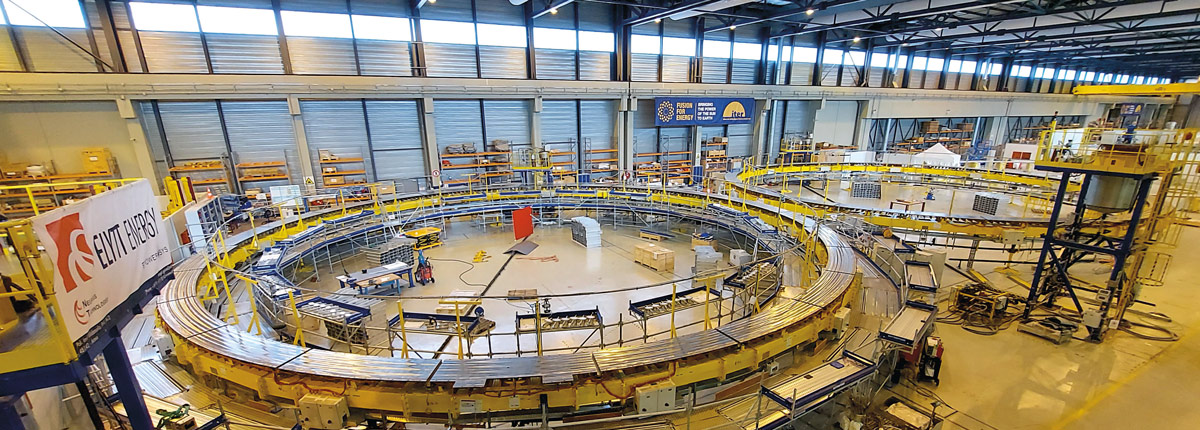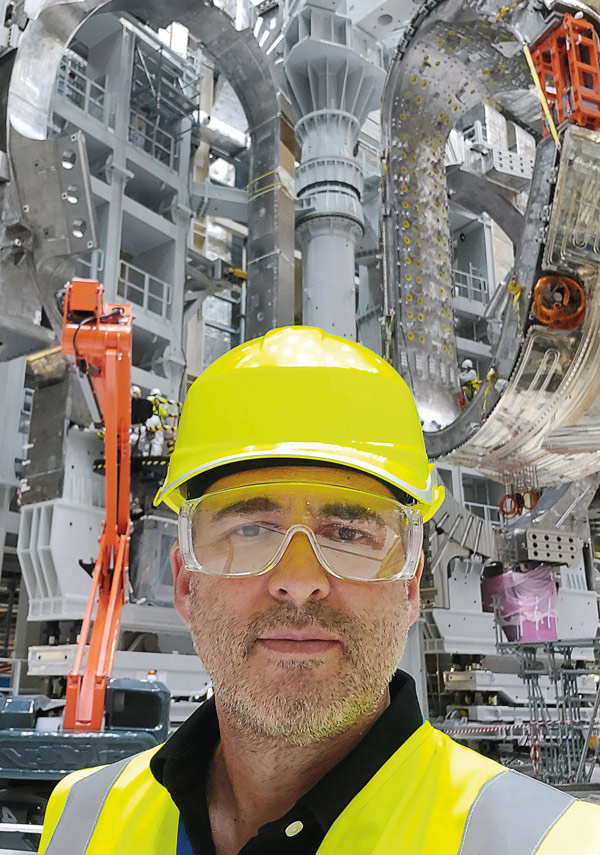
For the past 20 years, Eugenio Schuster, a professor of mechanical engineering and mechanics, has been part of an international team of scientists and engineers working at tokamaks, nuclear fusion reactors designed not to produce energy, but to help researchers study the physics of the plasma.
Their ultimate goal is to ensure the reality of sustained fusion—and the success of ITER, the world’s largest nuclear fusion reactor, which is being built in France. The machine is the product of an international effort to essentially harness the energy-generating power of the sun.
 Schuster (pictured in ITER's Assembly Hall) leads a Lehigh team that recently received nearly $1.75 million from the Department of Energy (DOE) to continue their work in support of ITER and to help the United States establish its own nuclear fusion reactor within the next decade. The award is part of a $47 million effort the DOE announced this past October to fund research aimed at closing the gap in science and technology when it comes to nuclear fusion.
Schuster (pictured in ITER's Assembly Hall) leads a Lehigh team that recently received nearly $1.75 million from the Department of Energy (DOE) to continue their work in support of ITER and to help the United States establish its own nuclear fusion reactor within the next decade. The award is part of a $47 million effort the DOE announced this past October to fund research aimed at closing the gap in science and technology when it comes to nuclear fusion.
Current tokamaks work in what’s called a pulsed regime, but they’re not created equal, says Schuster. Unlike the newer machines in South Korea (KSTAR) and China (EAST), those in the U.S. lack the superconducting coils necessary for extended operation.
“So, for example,” he says, “with the DIII-D tokamak in San Diego, the pulse is around six seconds long. So we run an experiment for six seconds, and then we have to wait for the machine to cool down before we can run another one.”
KSTAR and EAST are known as long-pulse machines, and can run on the order of hundreds of seconds, which makes them ideal for experimentation that could eventually be applied to ITER (which is also designed for long-pulse and eventual steady-state operation). Ultimately, says Schuster, for nuclear fusion to be economically feasible, future reactors will have to operate in very long pulses (in comparison to the time between pulses) or in steady state.
Part of Lehigh’s DOE award will support research at KSTAR, where Schuster’s Plasma Control Group—together with teams from General Atomics, Oak Ridge National Laboratory, and Princeton Plasma Physics Laboratory (PPPL)—will address critical research questions related to the development of ITER’s long-pulse scenarios and their active control. The remainder will fund research that Schuster’s group will do at EAST. One of the goals of that project, which includes teams from General Atomics, Lawrence Livermore National Laboratory, MIT, PPPL, and UCLA, is to guide the design of a fusion pilot plant (FPP) in the United States.
“DOE asked the National Academies of Sciences, Engineering, and Medicine to determine what was needed here in the U.S. to really advance nuclear fusion, and in particular, to bring fusion energy to the grid,” says Schuster. “One recommendation was the construction of a fusion pilot plant. That’s why the DOE is funding American researchers to do this work abroad. It will help us learn from these superconducting tokamak machines so that eventually, we can build a long-pulse reactor-degree device here.”
Schuster says the goal is to design, develop, and begin producing energy within 10 years.
“It’s a very aggressive timeline,” he says. Indeed, especially considering that ITER—with its 16-year head start—is not yet operational. The difference, Schuster says, comes down to investment and technology. “If you want to make things faster, you need to invest more heavily,” he says. “In the past, investors in nuclear fusion were exclusively governments, which are often constrained by budgets aligned with shorter-term priorities. But now, you have startup companies funded by billionaires, and they aren’t constrained in the same way. The DOE is presently developing partnerships with private investors to accelerate the development of fusion energy.”
The technological constraints have also changed dramatically. Developments in computational power and advancements in superconducting coils capable of generating ever stronger magnetic fields to contain the plasma have pushed the field forward, faster.
“We now have the capability to better predict the evolution of the plasma, thanks to more powerful computational resources, to understand the physics of the plasma more precisely after decades of studies, and to process the huge amount of data that comes from plasma experiments so that we can better learn from these experimental results,” he says. “So we do believe that we’re in a position to design and build this FPP much faster than we did with ITER.”
The promise of nuclear fusion is a big one: If achieved, it could provide a limitless supply of clean, safe, and reliable energy. And now, with the force of American entrepreneurship behind it, the efforts of Schuster, and so many researchers like him, may finally be realized.
“This fusion pilot plant is what we’ve all been working on and waiting our whole lives for,” he says. “It’s the opportunity to develop a type of energy that comes with so many benefits in terms of pollution, climate change, and fuel security—right here at home.”
Photos courtesy of Eugenio Schuster
